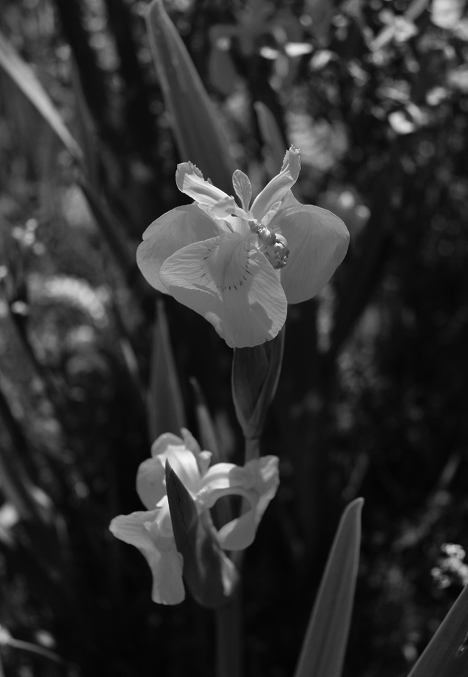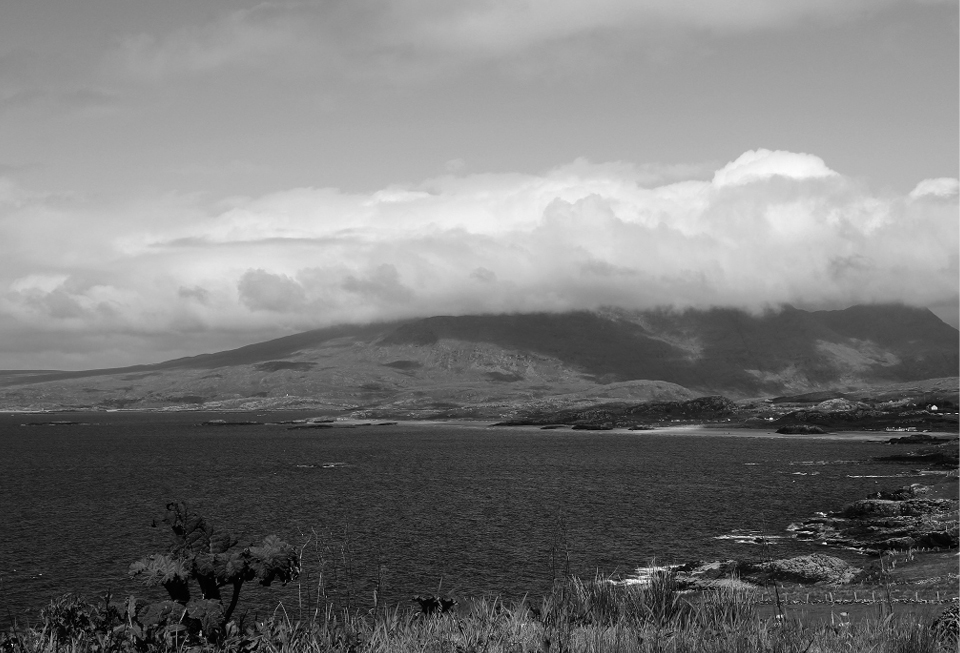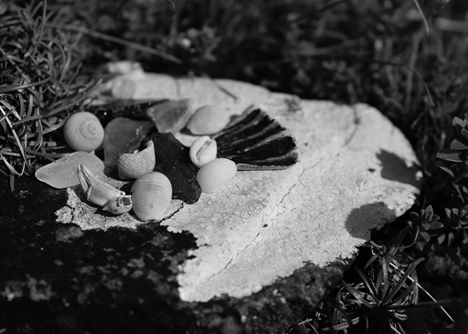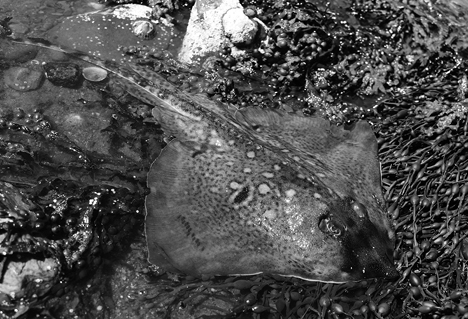



Photos by Sara Baume
On the last Friday in May, M. and I drive north west, circumnavigating Cork, Limerick, and Galway, the weather changing as often as the townland. Right from the outset, when we reach Connemara, I can tell we’re in Cross country. I recognise the rising, rolling landscape from her photographs, and in the swampy fields and ditches, the fox-gloves and yellow irises she casts into bronze. In the passenger seat, I am supposed to be studying my notes, but as we reach Killary fjord, I can’t bear to face them any longer. The sun is out, throwing theatrical shadows. Gravity-defying stone walls climb the slopes in wobbly lines. Gulls soar low, flicking the water’s surface with their wing-tips. The road ahead is littered with unkempt sheep.
I don’t need the notes anyway. I’ve been familiar with Cross’s work for twenty years, and this trip is a pilgrimage, of sorts, to meet a hero.
We get lost amongst the invasive species: behemoths of gunnera, swarms of rhododendron. We stumble across Rosroe pier and the hostel in which we are staying, opposite a converted cottage displaying a plaque which reads: LUDWIG WITTGENSTEIN, LIVED AND WORKED HERE, APRIL – OCT. 1948. I try to describe who Dorothy Cross is to the woman who runs the hostel in order to extract directions. She knows the house, but hadn’t realised an artist lives there. ‘I thought that lady did something to do with the sea,’ she says. Whale flashes through my mind, and Buoy, and Basking Shark, Currach, Finger Crab and Jellyfish Lake. ‘Well, actually,” I reply, ‘she does.’
*
I meet Dorothy Cross at the mouth of her driveway, in a fluster of wagging tail and wet shrubbery. We climb a short hill to the house and stop to look down again, past the road to where the land ends, spectacularly, in ocean and islands and clouds clinging, majestically, to mountain tops.
Cross is instantly welcoming and warm; she makes tea with mint leaves from her garden and presents it to me in a mug with a picture of a lobster on it. Her house is modest, still in the process of being transformed from a bungalow into something more unusual and particular – the front room has been emptied out to facilitate the installation of a new window, a bigger window, to better contain the uncontainable view. Everywhere I glance, there’s some detail of interest: a gourd embellished with cowrie shells, a row of rusty-lidded spice jars. From a hook on the back of the kitchen door trails a string of steel shark silhouettes; on the mantelpiece, wilted roses shed their petals into the fireplace. Walking through the house to the studio, I spot brain corals, bone ornaments, the udder bodhrán – there’s a drawing of a monkey skull by Barrie Cooke, a blocky little sculpture by Anthony Gormley – and everything is earth-coloured, worn, handled, history-infused. We talk about a habit we share: that of irresistibly accumulating interesting stuff in spite of the fact we essentially disapprove of materialism. And we talk about Room to Improve and Home of the Year and how disappointed we always are when each programme ends with a sterile, insensate white box.
*
The studio smells of incense. An ample work bench is flanked by tall shelves, cabinets, drawers, boxes. The roof is high and full of windows; the front is glass and sea-facing with a sitting area in one corner, alongside a log pile and a stove. Cross says there isn’t much to see at the moment but I am inundated. The studio is both a sepulchre for the offcuts and by-products of old works and an incubator for new generations and regenerations – pictures taped to the wall, pregnant materials. In many cases, Cross explains, a found item must rest for a long time, fomenting meaning, before a certain ‘collision’ occurs, and she is able to ally it to another. The air is thick with thought processes.
Cross is open and unguarded in her studio tour. ‘I’m developing an interest in eggs,’ she says, proffering hollow shells in cushioned boxes, some artificial and some real, shipped from Lithuania. ‘Duck, no, swan, no, gannet, no, heron … ?’ she guesses. There’s a wax egg on a wax anvil, emerald green; she describes it as a piece of ‘pure sculpture’, and the wax as ‘marvellously vulnerable.’ Also on the bench, there are shark teeth and fingertips cast in silver. Suspended from the ceiling, there are dried fins, skull fragments, the cast of the inside of a closed fist – a ‘squeeze’, she calls it – and a handful of meteorites; ‘I’m playing with this flip between the terrestrial and the celestial.’ Before we move from the bench, she removes a tiny jar of powdered gold from a drawer, ‘like eyeshadow’, and screws off the lid to demonstrate its brilliance. On the floor, there’s a Brazilian dodecahedron and an old Irish cash register, faced in beauty board, mouse droppings rattling about in the drawer. There’s a pile of white beach stones interspersed with marble mouldings – ‘I want to make a little building, a mausoleum; I’m interested in this combination of the carved and the natural’ – and finally, a pile of large sea-scarred drifted woods, from branches to beams: ‘This is the next thing now,’ she says, ‘I’m building a raft.’
*
It strikes me that Cross’s mind is a cauldron of ‘next things’. She speaks with exhilaration and conviction, skipping from subject to subject, sometimes never recovering the original strand. She has read both my books, even though I encouraged her not to, and questions me in the pauses between my questions to her. I’m keen to steer the conversation in the direction of new work, and she is as keen to share. ‘I have the offer of the use of a navy ship,’ she says, ‘and I could never say no; I just love all that hardware. But then there’s also the significance of an Irish navy ship – its role somewhere between protection and destruction, these vessels which have never shot their guns in warfare.’
The project is multiform, encompassing sculpture, performance, sound and film. ‘The ship,’ Cross explains, ‘is now spending a lot of time in the Mediterranean picking up refugees, many of whom are drowning, and for each body that drowns, there’s a heart at the bottom of the sea. And so my idea, very simply, is to have a human heart, and place it on the bow of the ship in a gilded box – not even visible, just as a presence.’
The second aspect of the work is musical, a collaboration between Lisa Hannigan – ‘whose voice is just so ethereal and angelic’ – and Alasdair Malloy, who plays the glass harmonica, which is like ‘a big chrysalis made of concentric bowls which fit into each other and water runs over them … and he’s like a priest, he has this little bowl of water and a linen mat and he dips his fingers to make this strange sound. I wanted to hear his instrument and Lisa’s instrument coming together, and the result is just stunning, like a weird mantra.’ The recording has already been made, but the project is still facing a great tangle of red tape, something which has always impeded Cross’s most ambitious endeavours, but has become increasingly shackling as the years go by. The main problem is the delicate matter of obtaining a heart.
‘I’m fascinated by the response I get when I talk about borrowing, acquiring – whatever the appropriate word is – a human heart. I understand the sensitivity, I’m not being callous, and yet, people are terrified.’ It’s something the artist had already proposed, several years ago, for a sculpture to be suspended from the ceiling of Chichester cathedral. The commission failed and the work became, instead, Shark-Heart Submarine (2011), a model submarine in white gold supported by an antique oak easel.
‘But then, I remembered, in the Wellcome Trust in London, in 2007, I’d visited an exhibition on the heart and its symbolism – examining and challenging this idea of it as the centre of all feeling and consciousness – and they had on display, in a little lead cyst, a human heart which had been found in Cork, in the crypt under Christchurch cathedral.’
She prints me a copy of the story of the Christchurch heart, discovered in 1863 in a recess ‘resting on a coffin lid, which had a metal plate with “1549” inscribed upon it.’ Cross chased it down to the collection of the Pitt Rivers Museum in Oxford and wrote a letter to the curator ‘all about the project and why it was so absolutely important that it be there, on board, and so perfect that it’s anonymous – we don’t know whether it was a woman or a man – only that it was taken from Cork, and so it would be coming home, even for just a day.’
‘I’m calling it Heart Ship,’ Cross says, ‘which I know is a little corny. But it had to be.’
It seems to me that Heart Ship makes reference to the refugee situation, but only softly, without sensationalism, and I suggest it represents a ‘sequel’ of sorts to Ghost Ship: a decommissioned light ship entirely coated in phosphorescent paint which spent three weeks in 1999 moored out in Scotsman’s Bay in Dun Laoghaire harbour. She concurs, but cautiously, and I realise ‘sequel’ is a term seldom used with regard to visual art, perhaps because of the assumption that each new piece grows from the last, inextricably. It prompts me to ask about her relationship to past work, a body of significant breadth.
‘Forty years! I sometimes look back and see the same things coming up again and again, and I question why I’m still working with the shark, why I can’t seem to find a new palette, whether it’s all just repetition – but then a friend said, complimenting me: it might be the same palette, the same source, but it’s more refined.’
The strength of the work as a body, by my reading, is the perspicacity of the accent which runs through everything; the fact that Cross set limits – or is receptive to the limits which set themselves – and then tests and stretches them to capacity, so that each finished piece is simultaneously unique and uniquely ‘Crossesque’. But what is this thing she calls ‘palette’ and I call ‘accent’? I suppose I understand it as the part the unconscious plays in creation, which beams through the work because of, as well as in spite of, the artist.
Here on her home ground, I’m struggling to separate the narrative of Cross’s life from that of her artwork. Surely the ordinary days are where palette, where accent comes from? I put to her the question of autobiography.
‘The only worry I have with people perceiving it to be autobiographical is that they will then renege their own responsibility of inhabiting the work. But I like the idea of art and life as a nervous system, that there can be the flurry of productivity and crystallisation, followed by a period of regaining balance. And living here provides that balance. I need the balm of this place – jumping in the sea this morning or whatever it is, to cleanse, so that I can start activating again. I have friends – artists who are much better known – who have studio assistants and work in every museum in the world. But you make a choice at a certain point. You can go a certain way; get on a plane and never get off. But I haven’t chosen that, because this is what keeps me alive, living here.’
*
Cross first came to Connemara for the clarity of its water, in order to scuba dive. Then she found a plot of land, bought it for next to nothing. At dusk, M. comes back, and we all go for a walk down ‘the field’, to the point where it drops off and disappears into the Atlantic Ocean. Part-wilderness, part-paddock, part-forest, there are overgrown paths, benches, bridges, creaky gates, ragged robin and a redwood, countless buttercups. There’s a vegetable patch, two bonfires-in-waiting and a leaky pond in which I discern the twitching of tadpoles, and Cross points out that these are only the runts – ‘it’s already summer, and so it’s unlikely they’ll ever grow into frogs now.’ This is something else the artist and I share: an irresistible attraction to ‘maligned creatures.’ There’s a rescue horse called Patch who we stop to feed carrots to, and Connie the dog was originally in training to be a guide dog, but failed to make the requisite standard. Now she crashes into the rushes and hustles out a pair of pheasants and they squall, squawking, into the air. The tour finishes with the sheds in which the artist initially lived and still, sometimes, prefers to sleep. There’s crockery upturned and drying on the deck; a golden Buddha on a high shelf watches over an array of peculiar treasures. It’s such a magnetic little domain – a private masterpiece. We linger a while in the shed garden, between the salvaged buoys and lobster pots, but the midges soon drive us back indoors.
Cross insists we stay for dinner, opens a bottle of wine and lights the stove and spoons fresh crab meat into lettuce leaves. Then there’s fried brill, new potatoes, tender-stem broccoli. We eat at the tiny table by the edge of her studio, surrounded by artworks, and dinner finishes with us each picking pin bones from the fish skin in order that Connie can have leftover brill for her breakfast. I cease trying to steer the conversation, and it trips naturally into vaguer territory: how to treat the sting of a weever fish, the peskiness of magpies, the emotional upheaval of developing an attachment to neighbouring livestock. And then there’s scuba diving, which fascinates me, perhaps even more so because I am afraid to do it.
‘It’s this thing about perception which I adore,’ Cross says. ‘When you dive, it’s all about visibility. Ten metres, twenty metres. In the Great Barrier Reef it could be one hundred metres visibility – like swimming through gin! But when it isn’t great, specifically in the South Pacific where it’s very blue water – if there’s a creature or another diver a short distance away from you, they become blurred, you start to not know where their edges are. It’s very very beautiful, but also a mind-wreck. You don’t know what you’re seeing or not seeing.’
‘And then there’s the buoyancy, the lack of gravity. You just float, it’s wonderful. I used to always have recurring dreams of floating through space – maybe that’s why diving came so naturally to me.’
We don’t leave until almost midnight, and Cross makes us promise to phone her if we get lost on the way back, or hit a sheep, and to return on Sunday at low tide, so that she can show me around her sea cave.
*
I spend most of Saturday sitting in the van on the edge of Letterfrack Bay, sheltered by the drizzle-blurred windscreen, combing through my recordings. It takes a while for the synchronicity to dawn on me; the reason I’m here is because M. is fishing for sharks – the little ones, members of the extended family, dogfish and bull husk and ray. One day, I am encountering them dead and dried and immortalised as sculpture; the next, I am standing on the pebbly shore as M. drags thornbacks from the waves, extracts his hook and bait from their throats with a pliers and lies them in the shallows for me to photograph. Then we watch as they recover their inner compasses and flap back out to sea – half swimming, half flying.
*
Sunday is windless and blue-skied, a perfect day for caving. We go early to the beach at Glassilaun and I tug a partially buried seagull spine out of the sand, and then compile, on a rock, a meagre assemblage of ‘Crossesque’ artefacts. A crab claw, a glass pebble, a shard of anemone shell against the lichen.
Back at Cross’s, we have coffee in the garden. She enquires after the sea view from our rented house in Cork, and I confess there’s no comparison – hers is spectacular, whereas mine is an unsteady isosceles triangle of blue which appears across the cow fields only on clear days. I want to ask about words again – apropos of my own difficulties with articulation, how I always feel that I let myself down by speaking; how it’s on paper that I feel I come closest to what I truly mean. Whereas Cross always chooses speaking over writing, though she is mistrustful of both.
‘With the TED talk, in 2012, they wanted me to write something down and learn it off by heart, but I can’t do that – it would kill the language. I would ruminate and dissect everything and surely end up saying nothing. It’s the same reason that I don’t paint. For me, writing is not about the writing itself. It’s about meaning, about navigating something. And so it’s all too easy to mislead somebody, because people do look at words as concrete.’
My own journey started in the realm of the visual, and then – perhaps due solely to the impatience of youth – I grew frustrated by my visual work not being understood as I wanted it to be, and rushed into the realm of words, where it seemed so much easier to simply tell people what I meant. Now it strikes me as an almost inevitable route. At a certain point, every artist is expected to explain themselves. In the early days of her career, Cross admits that she’d do anything to side-step speaking about her work. Nowadays she often does, but with a weather eye out for how words and images can so easily ‘contaminate’ one another.
‘Sometimes when I say things, they tie together in my head, but the significance or meaning might be in between what I say. Which is how I look at visual art as well – I believe the significance or meaning is actually what occurs in between the artworks.’
The problematic convergence of image and language is something she has confronted recently, for a piece commissioned by the Seamus Heaney HomePlace, as part of a series in which artists are invited to respond, visually, to one of his poetry collections. Cross chose Seeing Things and made a short film of the same name.
‘So I went through Seeing Things with my pencil and a little marker and tried to find things that I thought were beautiful. It was a bit panic-filled at the beginning – I was afraid I wouldn’t be able to do the piece, that I just wasn’t familiar enough with his work. It was only after watching a couple of documentaries on Heaney that I saw what I could do, and it was because the documentaries showed me what I couldn’t. They illustrated everything; there’s a poem about a little boy kicking a ball and the image is of a little boy kicking a ball. There’s a poem about a heron in a river and they show a heron in a river. And then on top of that there might even be background music! At the end, I just felt bombarded by overlapping elements.’
‘You know the notion of the blue screen, in film-making, how what is actually happening gets projected around it afterwards? And I realised that when I’m reading a poem, it’s a similar process. I read one line; I focus on the line and tend to miss everything else, and then project meaning back in afterwards. But that projection is unique to each reader, and so I decided I would take Seamus’s voice and hold it in blue, and then bring in blue images, which are in themselves quite poetic. Blue, for Yves Klein, was the colour of illumination. A fan coral under the water; Billy the horse getting up slowly from the grass, his muscles rippling.’
There’s a Cross photograph I love: Snow Mountain, Inagh Valley, Connemara. It shows – though I only know this because of the title – a snowy mountain standing against a whited-out sky, but the first time I saw it, I took it to be an enormous, frothy wave rising up from a raging sea. The photograph is a good example of this rich, nebulous zone ‘in between’ what is depicted and what is understood – it’s the same zone in which mystery, absurdity and poignancy occur. In another instance of synchronicity, Wittgenstein described it perfectly: ‘… if only you do not try to utter what is unutterable then nothing gets lost. But the unutterable will be – unutterably – contained in what has been uttered!’
I wonder how Cross feels about ‘working to order’, which seems to me at odds with the patient investigation she habitually applies to subjects and materials. ‘Well, I suppose every exhibition, in a funny way, is “to order”, in that you are given a space and they want you to put something there,’ she says. ‘Exhibiting is taking the opportunity to arrange the thoughts, and then the pieces – it’s choreographing.’
In between the dips and twists of our conversation, distant cows moo, garden birds twitter and sea birds shriek, a sheep dog arrives in the garden; he is part-blind and tragically thin. Cross goes inside to feed him a bowl of Connie’s kibble and a tin of sardines. ‘I do this every time he shows up,’ she says, ‘poor thing.’ She calls him Sailor.
*
When Cross bought her plot in the late nineties, she had not known that the expanse of rocky cliff where the field ends recedes into a deep sea cave, with multiple chambers. At the lowest point of the tide, a sequestered space is revealed, on the threshold between rock and sea. In more recent years, the cave has started to appear in her work, and so I’m already familiar with it, as art. Now she guides me down the cliff slope, crouching and scooting, crab-like. It’s a strangely black surface, knobbled, geometric. Connie waits higher up, neck bowed, forehead furrowed. The timing is perfect, though a thigh-high soaking is still par for the course. The artist has issued me with a pair of wetsuit socks, and now orders me to remove my trousers.
On a glittering summer afternoon in Connemara, in the wake of Dorothy Cross, baring my knickers, I drop into the icy water, and wade into a sea cave.
It’s dark, just for a moment, then it opens into sky, and from the sky, through a field gully, a waterfall patters down to meet us, chiming against the rock. The slosh and slap of seawater, the pools and paths of sunlight – it’s so thoroughly worth the embarrassment of exposing my pale legs. A carpet of minced kelp, walls studded with tiny barnacles and skinned with a suede-like, mahogany-coloured weed. And three bright buoys wedged in a crevasse, as if the waves had decorated it in honour of their proprietor, as if the field had somehow known a great artist had bought it, all those years ago, and scooped itself into this bewitching place – this in between place – neither fully quite outdoors or in, land or sea, nature or art.
